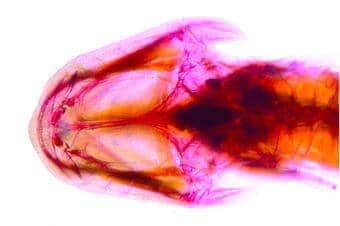Researchers from the U.S. Geological Survey and Louisiana State University have identified a new genus and species of cavefish from Mexico, the Oaxaca Cave Sleeper, which is the first cave-adapted sleeper goby to be found in the Western Hemisphere.
Researchers from the U.S. Geological Survey and Louisiana State University have identified a new genus and species of cavefish from Mexico, the Oaxaca Cave Sleeper, which is the first cave-adapted sleeper goby to be found in the Western Hemisphere. The fish, identified from museum specimens, has not been seen alive in more than two decades and lives in a cave system threatened by damming.
Gobies are the largest group of marine fishes. They generally live at the bottom of marine waters. “Sleeper” gobies lie still on the bottom as if they were asleep, and many species enter estuaries and rivers. The Oaxaca Cave Sleeper occurs in a single cave system beneath Presa Miguel Alemán reservoir, which is formed by a dam on the Tonto River, a tributary of Mexico’s second largest river. All other known cave-adapted sleeper gobies occur in the Indo-Pacific region.
Many surface-dwelling fish occasionally enter caves, but true cavefish have evolved over many millennia to spend their lives underground in complete darkness. They usually have no eyes, no coloration, and special sensory structures for navigation and locating prey. The Oaxaca Cave Sleeper’s adaptations suggest the species has an ancient history of living in darkness.
There are only 13 known individuals, all collected at the same time. Thomas L. Morris, a renowned cave diver and cave biologist who works to protect caves and their inhabitants, collected the fish in 1995. Morris gave the specimens to the Florida Museum of Natural History where Stephen Walsh, now a researcher with the USGS, recognized the distinctiveness of the new species while in the process of conducting taxonomic research and digitizing the museum’s fish collection. Walsh and colleague Prosanta Chakrabarty of Louisiana State University compared the specimens to other sleepers, and determined that they represent a new genus and species. The researchers gave the Oaxaca Cave Sleeper the scientific name Caecieleotris morrisi to honor Morris for his discovery and his dedication to conservation.
Cavefishes are important model organisms for the study of evolutionary biology. Because fish eyes are like those of all other vertebrates (including humans), the degeneration of eyes in cave-adapted fishes may provide insights about eye diseases and blindness.
Less than 0.5 percent of the world’s 34,000 described fish species are cave adapted. Because their habitats are vulnerable to environmental threats, most cavefishes are imperiled and a few may have gone extinct. “Conservation efforts for cave species often lag behind protection of species that are in more accessible habitats,” said Walsh. “The status of this new species is unknown, but its formal description should serve as an incentive for scientists to attempt to learn more about it.”
The identification of the new species highlights the importance of natural history museums in scientific discovery. “This species has not been seen by anyone in 20 years,” noted Chakrabarty. “If not for natural history collections preserving the world’s biodiversity, we would never have had the opportunity to discover it, name it, and hopefully try to save it.”
The USGS conducts key research in karst habitats–landforms characterized by limestone aquifers with an abundance of caves and springs. In addition, the USGS works with scientists throughout North America to assess the conservation status of imperiled aquatic species. Discovery of the new species afforded an opportunity for the USGS to partner with the natural history museum community in designating a scientific name for this unique cavefish. This is the first step in learning more about a species that could help guide future conservation efforts for many species of cavefishes.
The paper, A new genus and species of blind sleeper (Teleostei: Eleotridae) from Oaxaca, Mexico: first obligate cave gobiiform in the western hemisphere, was recently published in the journal Copeia, a widely-cited journal that publishes original research on fishes, amphibians and reptiles.


